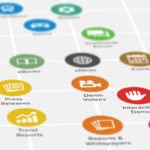4 Ways to Coach Your B2B Marketing Team to Write Compelling and Converting Copy

The Article in 60 Seconds
B2B tech marketing teams are judged on results. Results come, in part, from campaign copy that converts. How can you set expectations for your team and sharpen your copy project after project?
Do you have a foundation to build on? If so, concentrate on these four elements in every piece of copy.
Track your conversion rates over time and tweak copy to improve results.
Have You Laid the Foundation?
You pour the foundation of great copy when you mix two ingredients together to form the cement: a crystal clear understanding of your buyer and the conviction that your product solves their problem. Anything less than total confidence in these two elements will make your foundation soft. The entire building above will lean, or worse, crumble.
A solid foundation sets up your reader’s:
- Enthusiasm
- Epiphany
- Additional clicks
- Desire to provide information
- Longing for returning to your site
A poor foundation leaves your reader with:
- Confusion
- Ambiguity among choices
- Cloudy understanding
- Hesitation to click
Which experience do you want your readers to have?
1. Does the Headline Inspire?
Headlines show up in multiple places throughout the digital universe. When we refer to headlines, we mean any of the following:
- Email subject line
- Header text in an opened email
- First words on any webpage
- Most significant words on a landing or thank you page
- Key text at the beginning of the next section of copy in an article or long page
A successful headline keeps your readers engaged. It makes them curious (lists or questions). It slows down their searching. It entices them to be more careful in what they read elsewhere in the email or page (relevant). It provokes an emotional response. Make your headlines personal, pointed.
Your headlines are the most important writing you and your team will accomplish. They are the signposts for copy.
That makes headlines some of the most difficult copy to write.
Three Challenges to Craft Better Headlines
Teamwork
Review past and future headlines as a team with a spirit of collaboration. One by one, display headlines on the screen and let your team sharpen each other and the headlines by tweaking them.
Deploy Tools
Many companies have created tools to help you test or grade your headlines. They do not make your work perfect, and these tools are oblivious to your foundation (see above). Use these tools to remind you of other techniques or as a brainstorming aid, but never let them make your final decisions.
Golden Spiral’s List of Verbs: Often the action you prompt is the most important factor. This list helps you make your headlines stronger. DOWNLOAD
Zurb: What does your email subject line look like in the real world?
CoSchedule: Their free headline and subject line grading tool looks at multiple factors.
ShareThrough: Their analyzer offers suggestions and reminds you of strengths. Note: they are looking for completely different factors than CoSchedule, so using both might give you a headache. Remember, you know your audience and your solution. Follow your experience and gut for final decisions.
Other tools: This helpful article from HubSpot lists other tools that might fit your team better.
A/B Testing
Continually test and review the statistics. Ensure you have a purpose to your tests. For example:
- Test headlines with “you” in the copy versus those that imply the word.
- Test edgier content versus more traditional
- Test short versus long
The results will stir up fabulous discussions with your team around refining headlines.
2. Does the Call to Action Compel?
We provided effective call to action examples in this article. Many factors play into buttons, placement, and more. Be sure to dive deep to get a full understanding of writing calls to action.
The copy in your calls to action — both the set up and the button — is the second most important piece of copy you’ll write for each movement you want your prospective customer to make.
Whether overt or implied, every call to action needs to follow the rhythm of pain and relief.
Whether overt or implied, every call to action needs to follow the rhythm of pain and relief.
- You have a headache. Take an aspirin.
- You sprained your ankle. Let me wrap and ice it for you.
- Your brakes are squeaking. I can put new pads on in less than 30 minutes, and they come with a lifetime guarantee.
The pain should be specific to the actual message. Addressing one facet of your prospects’ pain points at a time sets up a more acute response.
3. Does the Body Copy Prompt Response?
There are hundreds of thousands of articles on how to write better copy. There are companies that net millions every year selling products, methods, classes, and coaching.
How many have you invested in over the years?
In the world of fitness and weight loss, the ultimate keys are simple. One must consume fewer calories than one burns in a day to lose weight.
How one accomplishes that has launched industries, authors, and brands.
Think about the high protein/low carbohydrate motif. Those who try this nutrition plan can get so caught up in counting the grams of protein and carbs, the diets, and more that they miss the core: if you don’t consume fewer calories than you burn, you won’t lose weight.
The same can be true for whatever copywriting system you look to.
Don’t get so consumed in the system that you forget what you’re trying to accomplish.
The best copy, even in the B2B space:
Addresses the reader personally — The more you know your target, the more you can read their minds, and whisper in their ears.
Engages as many senses as possible — We are humans, not machines. We interact with our world through touch, taste, smell, sound, and sight.
Provokes an emotion — It’s one thing to see or smell; it’s another thing to feel fear, hope, anger, gladness, etc.
Commands an action — Never assume that if you present your case, the reader will do something. Order them to. They may disobey the order, but at least they did something.
4. Do Your Follow-Ups Invite More Interaction?
 Saying thank you is important. But is it enough?
Saying thank you is important. But is it enough?
Two Follow-up Traps
Too Many Options
In your thank you and confirmation communication, offering an opportunity to read, download, or demo another resource is a fantastic idea. Giving them too many to chose from is a problem. If you don’t know what your prospect needs, you will have a higher probability of falling into the trap of too many options.
I recommend “two plus one.”
We are often binary — on/off. If you only offer one option, the response is either yes or no. If you offer two, you’ve doubled your chances of a response. The choice is still binary, but the prospect now can choose A or B.
The plus one is a (much) smaller image to click or can feel like a PS in your text. I recommend it feels like a secret bonus or an inside track. If the plus one is high touch — phone call, personal response to an emailed question, etc. — all the better.
Going for the Jugular
You want everyone you meet to buy. You know you must “ask for the sale.” However, in marketing, this is akin to going to a speed dating session at a restaurant and opening every 3-minute interaction with, “Will you marry me?” What is the best “second date” resource you have available? Offer that in your two plus one.
The First Thing to Do After Reading This Article
Assemble your team and look at a single engagement you’ve prepared for your audience. From headline through followup, break it down. Where can it be stronger, better, more engaging? Use these four questions to look at its parts and put it back together again.


